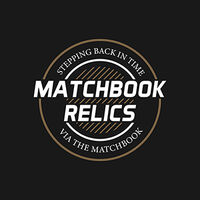In the mid-20th century, ambulance services found an innovative and practical way to promote their business: vintage matchbooks. These small, everyday items served as powerful advertising tools, helping ambulance companies reach a broad audience and ensure that their vital services were well-known within the community. Notably, during the 1940s to 1960s, it was common for funeral parlors to operate ambulance services, often using hearses as ambulances. This article explores how ambulance companies, including those run by funeral parlors, ingeniously utilized matchbooks to promote their lifesaving services.
Matchbooks as Lifesaving Advertisements
Ambulance companies used matchbooks to provide essential information about their services in a compact and easily accessible format. The covers of these matchbooks often featured the company’s name, logo, and emergency contact number, along with slogans like "In Case of Emergency, Call [Number]" or "Your Lifeline in Crisis." These matchbooks sometimes included images of ambulances or medical symbols, reinforcing their role in providing emergency care.
By distributing matchbooks widely in local businesses, restaurants, and community centers, ambulance companies ensured that their contact information was always at hand. The practical utility of matchbooks meant they were frequently used and kept in easily accessible places, such as kitchen drawers or car glove compartments, making them a reliable resource in emergencies.
Promoting Dual Services of Funeral Parlors
In earlier times, many funeral parlors operated ambulance services, using hearses as ambulances. This dual role was effectively promoted through matchbooks, which featured both the funeral home and ambulance service information. Covers might display the funeral home’s logo, name, and contact information, with an additional section highlighting the ambulance service. Slogans like "Caring for You in Life and Death" or "Emergency Response and Funeral Services" communicated the dual functions of these businesses.
By using matchbooks to advertise both services, funeral parlors ensured that their community was aware of the comprehensive care they provided. This dual promotion helped build a reputation for reliability and compassion, crucial for businesses dealing with both emergency medical services and end-of-life care.
Building Trust and Community Presence
The use of matchbooks helped ambulance companies and funeral parlors build trust and establish a strong presence in the community. The designs often included reassuring symbols, such as crosses or medical caduceus, and messages emphasizing promptness, professionalism, and care. By distributing these matchbooks, companies positioned themselves as essential and reliable services, fostering trust among community members.
The continuous presence of these matchbooks in daily life helped reinforce the idea that ambulance services were always ready to assist in emergencies. This constant visibility and the practical nature of matchbooks helped build a sense of reliability and trustworthiness.
Educational Outreach and Awareness
Matchbooks also served as educational tools, promoting awareness about emergency preparedness and the importance of quick response in medical crises. Some matchbooks included brief tips on what to do in an emergency, such as "Stay Calm, Call [Number], Provide Clear Information" or instructions on basic first aid. This added value helped position ambulance companies as knowledgeable and proactive community resources.
By providing helpful information, ambulance companies not only promoted their services but also contributed to overall community safety and preparedness. This educational outreach reinforced the companies' role as essential service providers committed to public well-being.
A Touch of Nostalgia and Collectibility
The nostalgic charm of vintage matchbooks contributed to their effectiveness. The simple yet impactful designs and the tangible nature of matchbooks evoked a sense of tradition and reliability. Many people kept these matchbooks as collectibles, further extending their reach and impact. They served as cherished reminders of the ambulance services' role in the community and the importance of emergency medical care.
Conclusion
The use of vintage matchbooks by ambulance companies, including those run by funeral parlors, was a strategic and effective way to promote their lifesaving services. By turning these everyday items into valuable sources of information and reminders of their presence, ambulance companies ensured that their contact details were always accessible in emergencies. The practical utility and thoughtful design of matchbooks helped build public awareness, foster community trust, and enhance the visibility of their essential services. Today, these vintage matchbooks serve as charming relics, illustrating the innovative ways in which ambulance companies connected with their communities and promoted their vital mission of emergency care.
